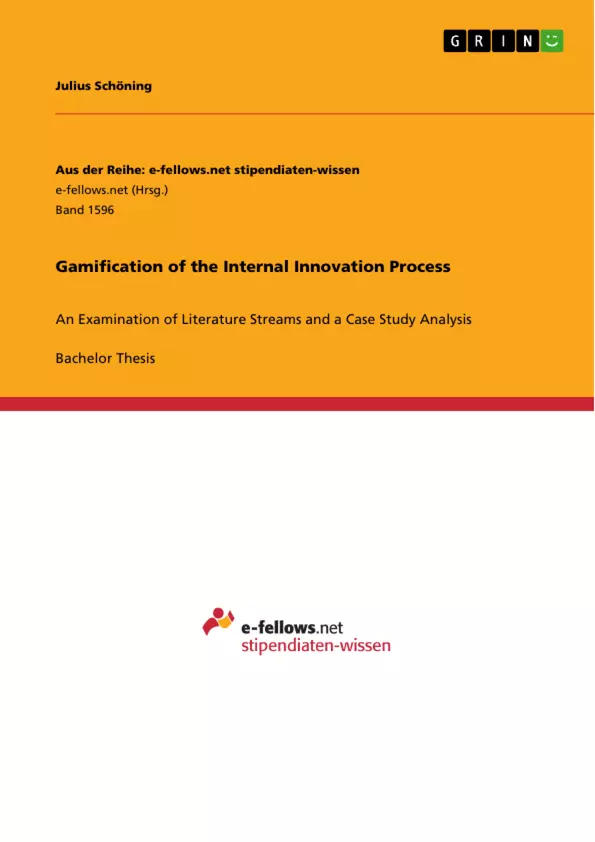Gamification has been hyped during the last years. There are studies predicting an enormous rise of the rate of companies gamifying their innovation process. Nevertheless, the majority of those projects are supposed to fail because the application might be designed poorly.
In this thesis, a comprehensive examination of theoretical background is delivered, the providers of gamification software are ascertained, case studies of some of their completed projects are analyzed, and interviews are conducted with implementing consultants.
The thesis concludes that gamifying an innovation platform for time-restricted innovation challenges can be a very powerful and successful management tool if implemented properly. Open-ended gamification approaches of innovation platforms usually fail to meet its business objectives in the long run because participation decreases over time.
Inhaltsverzeichnis (Table of Contents)
- Abstract
- Table of Contents
- List of Figures
- List of Tables
- List of Abbreviations
- Introduction
- Relevance and Problem Statement
- Research Question
- Sub-Questions
- Overview
- Theoretical Background
- Innovation Management
- Classification of innovation
- The Innovation Funnel
- Electronic Brainstorming
- Understanding Human Motivation
- Different Kinds of Motivation
- Self-Determination Theory
- Organizational Psychology Types
- The Emergence and Possible Enhancement of Motivation
- Categorization of Extrinsic vs. Intrinsic Motivation at the Workplace
- Gamification
- Towards a Definition
- Origin
- How Gamification Works
- Player Types
- Game Elements/Game Mechanics
- Game Dynamics
- Linking Innovation Management, Electronic Brainstorming, and Gamification
- Gamification Design Process
- Critique
- Methodology
- The “Building Theories from Case Study Research\" Model
- This Thesis' Approach Based on Eisenhardt's BTCM
- Results
- Within-Case Analysis
- Open-ended Approach
- Challenge-based Approach
- Cross-Case Analysis
- Conclusion
- Limitations of this Thesis and Future Research
- Limitations
- Future Research and Outlook
- Reference List
- Appendix
Zielsetzung und Themenschwerpunkte (Objectives and Key Themes)
This thesis aims to explore the effectiveness of gamification within the context of internal innovation processes. It examines existing literature on gamification and innovation management, analyzes case studies of gamified innovation platforms, and conducts interviews with implementing consultants. The goal is to determine whether gamifying an innovation platform can be an effective management tool and to identify factors that contribute to its success or failure.
- The application of gamification principles to internal innovation processes.
- The effectiveness of gamification in motivating employees and fostering creativity.
- The impact of different gamification approaches on innovation outcomes.
- The importance of proper implementation and design for successful gamification.
- The potential limitations and challenges associated with gamifying innovation platforms.
Zusammenfassung der Kapitel (Chapter Summaries)
The thesis begins by introducing the relevance and problem statement, outlining the research question and sub-questions. Chapter 2 provides a comprehensive theoretical background, exploring concepts such as innovation management, human motivation, and gamification. It examines different types of innovation, the innovation funnel, electronic brainstorming, and various motivation theories, including Self-Determination Theory. The chapter then delves into the definition, origin, and mechanics of gamification, linking it to innovation management and electronic brainstorming. It concludes with a discussion of the gamification design process and its critiques.
Chapter 3 presents the methodology used in the research, focusing on the "Building Theories from Case Study Research" model and its application in this thesis. Chapter 4 presents the results of the case study analysis, examining both open-ended and challenge-based gamification approaches. Chapter 5 concludes the research, summarizing the findings and discussing the limitations of the study. It also offers insights into potential future research and outlook.
Schlüsselwörter (Keywords)
The primary focus of this thesis lies in the intersection of gamification, innovation management, and internal innovation processes. Key terms include gamification, innovation, motivation, electronic brainstorming, case study analysis, implementation, design, and effectiveness. It examines the application of gamification principles to internal innovation processes and analyzes the factors contributing to the success or failure of such implementations.
- Arbeit zitieren
- Julius Schöning (Autor:in), 2014, Gamification of the Internal Innovation Process, München, GRIN Verlag, https://www.grin.com/document/300582



